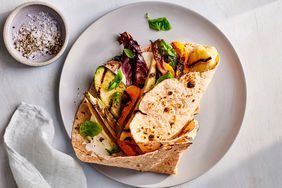
Sydney Bensimon
What’s more comforting than a grilled cheese sandwich with crisp, golden brown bread and melting cheese? Nothing. The ingredients are simple, but together, they make what is arguably the most popular sandwich around. If you learned to make grilled cheese by slathering the slices of bread with softened butter, you’re on the way to perfection. But there's one more spread you should be using in addition to butter: Mayonnaise. Ahead, we reveal our unique method for adding mayo—and we spoke to a food scientist who explains why mayonnaise makes a great grilled cheese even better.
Bryan Quoc Le, Ph.D., food scientist and author of 150 Food Science Questions Answered
Mayonnaise Makes a Difference
You probably have this humble condiment in your refrigerator. Mayonnaise is key to everything from tuna sandwiches to potato salad, but you might not be using it to improve your grilled cheese—yet.
While we admit that there's no such thing as a bad grilled cheese sandwich, some are better than others, and adding mayonnaise is an easy instant upgrade. It yields a perfectly golden brown crust every time. Whether you eat the sandwich on its own or pair it with a bowl of creamy tomato soup, we promise you’ll never go back to using just butter again.
How to Add Mayo to Your Grilled Cheese
Some swear by straight butter, others by 100 percent mayonnaise. We like to split the difference and combine both fats to make our grilled cheese sandwiches.
There are several ways to use the butter-mayo combination on your grilled cheese but after careful testing, we can assert this is the best approach: Mix the mayo into softened butter and spread that on the outside of both slices of bread.
Mayo-to-Butter Ratio
We like to keep things simple and use a 1-to-1 ratio for the best browning and flavor, but you could use a little more mayo than butter or vice versa. Either combination will produce a delicious grilled cheese.
How Mayonnaise Improves a Grilled Cheese
The results spoke for themselves when we compared the differences between butter-only and adding mayonnaise when making grilled cheese sandwiches in our test kitchen. But we wanted to know why mayonnaise reacts so differently from butter. We spoke to Bryan Quoc Le, Ph.D., food science consultant and author of 150 Food Science Questions Answered to learn more.
Iron
Butter and mayonnaise are both emulsions made up of fat, water, and protein. So why do they behave so differently? It comes down to iron. Mayonnaise is made with egg yolks, which not only have fat, protein, and emulsifying agents but also significant levels of iron, according to Le. "When heated to high temperatures, the iron helps catalyze the reaction between the sugar and carbohydrates in the bread with the proteins in the bread and egg yolks," he says. If you're familiar with something known as a Maillard reaction (which you see most often with iron-rich meat), this is very similar. The reaction happens more quickly with mayonnaise due to its iron content. The same thing will eventually happen with butter, just at a much slower rate due to the lack of iron as a catalyst.
Smoke Point
Le also points out that mayonnaise, which is usually made with canola or soybean oil, has a higher smoke point than butter. "Mayonnaise can have a smoke point of up to 450 degrees Fahrenheit, whereas butter can be anywhere between 325 to 350 degrees depending on the season, type of cattle, and what the animals are fed." Lactose isn’t found in mayonnaise, and the fat compositions are far less complex. The presence of milk proteins and lactose sugars in butter makes it scorch quite easily. In short, butter is much more likely to burn than mayonnaise.
Advantages of Using Both Mayonnaise and Butter
Here is why we prefer using both butter and mayonnaise for the perfect grilled cheese.
- Texture: Mayonnaise and butter will both help create a crisp texture on the bread, so why not combine the two? Mayonnaise helps create a Maillard reaction, which contributes to the golden brown color and crunchy texture. It also ensures that the bread won’t burn before all of this is achieved.
- Flavor: Butter adds a unique, rich, fatty flavor that you can’t get from only mayonnaise. The perfect texture is all good and well, but we’re looking for an amazing flavor, too.
- Even browning: An even layer of mayonnaise and butter produces the most even browning on the bread. Not to mention, there won’t be any burnt spots around the edges, thanks to the mayonnaise.
- Affordability: Butter can be quite expensive; mayonnaise is more affordable. Chances are you have both of these spreads in your kitchen already, so it’s easy to incorporate some mayonnaise, even if you’ve been religiously making grilled cheese sandwiches solely with butter up until now.
:max_bytes(150000):strip_icc()/riley-wofford-2018-81632856279842519548bc607969b36f.jpg)














